Home Alone? No problem for the ACO’s superstars
By John Shand, Kate Prendergast and Peter McCallum
MUSIC
ACO unleashed
City Recital Hall, June 28
Reviewed by PETER McCALLUM
★★★★★
Faced with a late cancellation by guest director Patricia Kopatchinskaja, and with ACO Director Richard Tognetti already committed elsewhere, the Australian Chamber Orchestra were suddenly faced with a Home Alone situation, which, needless to say, they navigated without missing a musical or metaphorical beat.
The blend of talent, expertise and renewal they can draw on in such situations was nicely displayed from the very first note of Bach’s glorious Concerto for Three Violins in D, BWV 1064 played by three soloists whose collective experience with the ACO exceeded the orchestra’s 50 years of existence; Helena Rathbone (ACO Principal Violin for 31 years), Satu Vanska (ACO Principal Violin for 20 years) and Anna Da Silva Chen (ACO Violinist for one year).
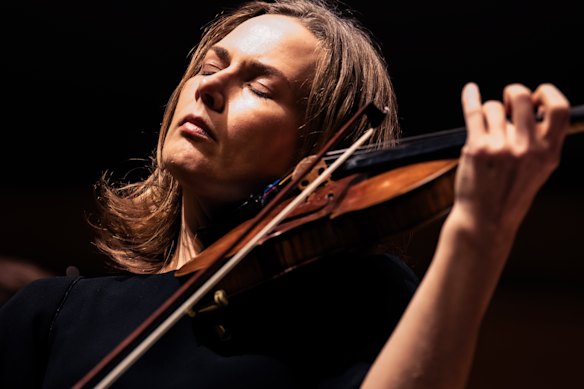
Satu Vanska brought aplomb and sang-froid to Ravel’s Tziganne.Credit: Nic Walker
Beside them in the orchestra were cellists Melissa Barnard (marking 30 years with the ACO this year) and Timo-Veikko Valve (Principal Cello for 19 years) and a rich complement of comparable musicianship in the rest of the orchestra.
The particular delight of the Bach concerto was the way the graceful interplay of lines allowed the artistic personalities of each players to emerge, Vanska bringing a subtle edge, Rathbone finely attuned warmth and Chen blooming energy.
Vanska then returned as soloist, impatient to embark on the outrageous virtuosity and sophistication of Ravel’s Tzigane arranged by Bernard Rofe. She ground out the sultry opening solo on the G string, before chipping off dry pizzicato, icy harmonics and tongue-in-cheek daredevilry with aplomb and sang-froid.
The first half concluded with a complete change of mood, a string orchestra arrangement by Tognetti of Beethoven’s most compressed and expressively explosive string quartet, the Quartetto Serioso in F minor, Opus 95 led by Vanska. In the first movement, the ideas erupted, flipped to pathos and flitted so quickly that, almost as soon as one had adjusted to the rapid flow of expressive utterance, it was over.
In the second half Rathbone led Schubert’s Quartettsatz in C minor, in a performance of superb precision and balance. It started with breathless agitation, opening up subsequent phrases with classic shape to round out the whole with balanced formal clarity.
To finish, with Rathbone leading the orchestra, Valve gave a deeply felt, arresting Australian premiere of the Cello Concerto, Opus 38 by his close colleague and friend, the late Jaakko Kuusisto (died 2022).
This was a work of tight motivic integration and powerful expressive impact and Valve played like a seer speaking a hard-won truth, full of intensity, sincerity and deep musical understanding.
Arabella Steinbacher performs Prokofiev
Sydney Symphony Orchestra
Sydney Opera House, July 3
Reviewed by PETER McCALLUM
★★★★½
Arabella Steinbacher played Prokofiev’s Violin Concerto in G minor, No. 2, Op. 63 with a musicality born of precision, warmth and inscrutable finish. The concerto begins on the violin’s lowest note with a melody of modest simplicity that restricts itself to a few motives yet even within this deliberately circumscribed framework, Steinbacher found mellifluous natural shape.
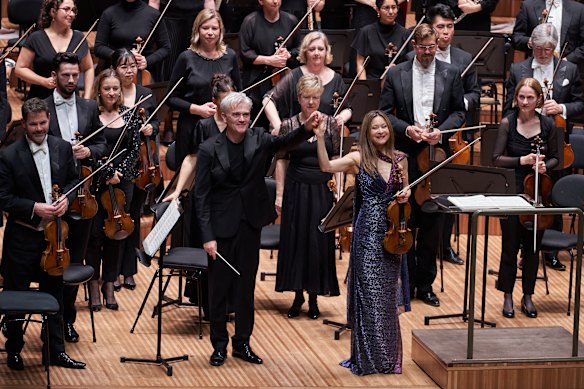
Arabella Steinbacher with conductor Edward Gardner. Credit: Jay Patel
Her playing has impeccable rhythmic neatness, which is a great boon with Prokofiev who likes to shift tone from the serious to the sarcastic without a wink. Yet Steinbacher never undermined the tone with a hint of grotesquery.
Prokofiev wrote the work just before returning to Stalinist Russian and, following cues in the music of Shostakovich, Western listeners have sometimes liked to hear Prokofiev’s Soviet music as double-coded - a happy public face masking hidden critique.
Yet in the slow movement of this concerto, whose melody and doggedly simple arpeggiated accompaniment have prompted some commentators to suspect satiric intent, Steinbacher played with unabashed sweetness and beauty of line so that the intriguingly orchestrated neo-classical shapes came across not as ironic but simply as strikingly original. She maintained this polish through the rustic finale, generating excitement through rhythmic crispness without exaggeration.
Steinbacher’s performance was framed by two works of Impressionist sensibility, arion by young Australian composer William Gardiner and the complete score of Ravel’s masterpiece Daphnis and Chloe.
Gardiner’s work opened with pulsations on vibraphone and a light string sounds that were given murky cross-rhythmic complexity. This opening settles to stiller, more transparent musical fabric, which thinned at the close, like clearing mist.
After interval, guest conductor Edward Gardner, Principal Conductor of the London Philharmonic Orchestra, allowed Daphnis and Chloe to emerge from near-silence. Distant harp notes, a gently animated flute melody and ethereal choral utterances led gently to the haunting horn motif that is sometimes taken to represent, in its initial and inverted forms, both of the main characters.
The music whelmed to evocative surges of orchestral and choral sound and the care that Gardner, the Sydney Symphony and the Sydney Philharmonia Choirs took over the Introduction to Part 1 set the scene for an entrancing hour of exquisitely shaded textures. Gardner and the SSO ranged from sensuous stillness and languor to moments of intense dynamic vigour and energy.
In Part 3, the swirling animation of orchestral timbres and iridescent exaltation of the wordless choral sounds during the Daybreak scene, and flautist Emma Sholl’s brightly enticing solo in Daphne’s dance set the scene for an exciting close of breathless exhilaration.
Divine Darkness
Ensemble Offspring
The Neilson, ACO on the Pier, July 3
Reviewed by PETER McCALLUM
★★★½
Entropic Arrows by Icelandic composer Anna Thorvaldsdottir (now based in London) began with a busy texture of notes from four string players, all at cross purposes. These thinned to allow the two wind players, flute and bass clarinet, to pursue a similar thought more quietly with Ensemble Offspring director Claire Edwards adding fine lines to the sonic fabric on percussion.
As the piece progressed, these clusters of activity were filtered to allow long notes to emerge, which the composer likened to a “fragile flower being carried in the performers’ hands as they walk the distance on a thin rope, without dropping it or falling”.

Jane Sheldon with Ensemble Offspring.Credit: Jared Underwood
The piece ended in quiet transcendence and, in the exacting hands of conductor Jack Symonds and Ensemble Offspring, not one flower was dropped. Thorvaldsdottir has attracted growing international attention for her finely etched sound worlds evoking inner sensibility and vastness and her piece made an apt beginning for this program exploring numinous stirrings within dark spaces.
Australian singer and composer Jane Sheldon began her piece, Come, dark sigh, (receiving a world premier) by gentling shaking a small drum to which a string was attached to excite soft sepulchral noise within.
The work explored the Buddhist concept of vibhava-tanha – pursuing a desire for non-existence as a path to transcendence. Sheldon started to sing in subdued low register before quickly sweeping to vivid high notes against supportive murmurs from the instruments, evoking the eerie and the strange.
It ended with Sheldon blowing premonitory blasts on what I took to be a Laotian mouth organ or khaen while other players twirled plastic tubes to create a low moan like a quiet wind over the grave.
Contrasting with these delicately nebulous textural essays, Ghostlight by American composer David T. Little progressed in four sharply defined and contrasting movements. The first was a ghostly invocation starting on vibraphones within a clearly outlined rhythmic framework on the piano, while the second movement, the most striking, moved with an arresting and implacable bass drum tread.
The third was suddenly quiet evoking insect-like buzzes while the fourth thinned out to child-like simplicity and peace implying resolution. Rainbow Dust in the Sky by Italian composer Daniela Terranova was a small, softly gleaming piece for string trio, the instruments amplified to focus on the minute sounds of fingers on fingerboards as though to capture the birth of sound at the moment it is uttered.
Finally, Australian-born, UK based Lisa Illean’s Cantor set poems by American writer Willa Cather over seven short movements. Sheldon sang simple melodies subtly inflected with micro-tunings against delicately shaded instrumental ideas, progressing with the contemplative stillness of drifting clouds.
MUSICAL THEATRE
Being Alive: The Music of Steven Sondheim
Hayes Theatre, June 26
until July 12
Reviewed by JOHN SHAND
★★★½
Stephen Sondheim’s songs are too rarely lifted from their shows to stand alone, whether on records or in cabarets. They’re variously perceived as being too context-specific, too cerebral or insufficiently melodic. Being Alive is another reminder of how nonsensical this is. Letting his songs bump into siblings from other shows highlights their richness, not just musically and lyrically, but in terms of their humanity.
No one discusses the richness of the depiction of the human condition in the work of other writers of musicals, not even Rodgers & Hammerstein, Kander & Ebb or Lerner & Loewe. In this regard, Sondheim’s artistry has more in common with Shakespeare, Tolstoy and Chekhov.
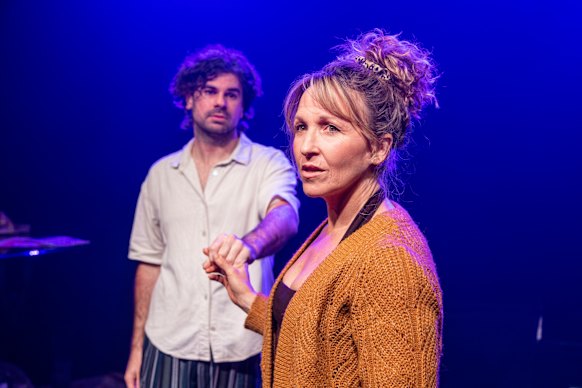
Lincoln Elliott and Blazey Best. Credit: John McRae
Instead of girls meet boys and running off into the moonlight, flawed people delude themselves, well-meaning people regret, assassins confront their imminent execution, and, in his ultimate masterpiece, Sunday in the Park with George, an artist sings of the very impulse of the creative act.
Devised by director Sonya Suares and musical supervisor Luke Byrne for Hayes Theatre Co, Being Alive is a treat for Sondheim fans, but it’s not all it could have been. Firstly, given the wealth of material at their disposal, it’s too short.
At about 70 minutes, it seems we’ve only just settled in when they’re already sending in the clowns and switching on the house lights. No one would have blinked had we been asked to be engaged, stimulated and moved by the man’s songs for another half hour.
Then there are missteps, like having Not While I’m Around intrude upon Send in the Clowns. What were they thinking? That they had to squeeze something form Sweeney Todd in somewhere? That we’d grow bored while Blazey Best was trying to shred our hearts with Sondheim’s best-known song?
Losing My Mind (Follies) and You Could Drive a Person Crazy (Company) are attenuated and forcibly mated in a way that neither song finds comfortable or pleasurable. Then they end with such a truncated Comedy Tonight (A Funny Thing Happened on the Way to the Forum) that it’s more fitting for an ad than a celebration of its creator.
Happily, there’s also much to admire, including Best underplaying Clowns: delivering the intimate musing of a vulnerable woman, rather than anything resembling a showstopper. Raphael Wong and Lincoln Elliot are blessed with attractive tenor voices, the former shining his on the luminous, mind-expanding Color and Light from Sunday in the Park, while the fourth singer is the livewire Kala Gare, whose fuller voice is an ideal foil for Best’s more brittle tone.
The indefatigable Michael Tyack directs the music from the piano, accompanied by bassist Amanda Jenkins and clarinettist Lillian Hearne, with Wong also playing cello on two pieces. If it’s not a perfect tour of Sondheim’s genius, it will still delight his devotees.
MUSIC
MIKE NOCK QUARTET
Foundry 616, June 27
Reviewed by JOHN SHAND
★★★★
So it’s goodnight to Foundry 616, the love child of a man whose passion has been presenting jazz in Sydney for more than 40 years, Peter Rechniewski. People get Orders of Australia for doing much less. This was a hell of a penultimate gig, featuring the pianist who played the venue’s first concert 13 years ago, Mike Nock.
Across a career spanning seven decades, primarily in New Zealand, the US and Australia, Nock has proved himself a composer, improviser and band leader of the highest calibre. This was instantly evident on the opening Not We But One.
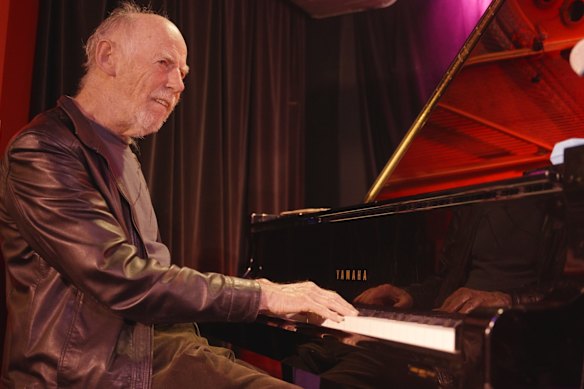
Mike Nock on the penultimate night of the much-loved Foundry616 venue.Credit: Richard Corfield
Nock tells stories in music, and he distils essences of emotion. Here little wisps of melody from the piano provoked response, commentary and elucidation from bassist Brett Hirst and drummer Toby Hall, the latter playing with his hands against Hirst’s groove, while Nock floated lines above them that were, by turns, pensive and supremely lyrical.
Then, as the composition’s title suggests, the three instruments seemed to converge, and the interaction had a profundity like fine poetry, where each word contains a deeper truth. This was music playing the musicians, rather than the other way around, and it stayed at this peak when tenor saxophonist Karl Laskowski joined, generating a gruff sound, and playing short, stabbing phrases that drove the groove rather than riding on it. Nock then reoccupied the foreground, finding typically surprising implications in what the rhythm section was offering.
The band slipped back into a safer place with Foundry Start-Up Blues, although Laskowski grabbed the piece by the scruff and made it raw and real. Much more engrossing was the contemplative Acceptance, which had Nock making little rivulets of melody flow into the gentle, bossa nova-tinged groove, before Laskowski played a solo as languid as floating downstream in a dinghy without resort to oars.
Hall crafted a stonking, bucking solo on the boppish Transitions, and Hirst, Nock’s longest-serving collaborator, soloed with sinewy vigour on a blues in the second set, which also featured Laskowski deploying the brawny sound and loping lines beloved of Texan tenor saxophonists.
Every composition presented different facets of Nock the composer and Nock the improviser. One moment we’d hear his love of rhythmic puzzles and child-like joy in the game of making music, and the next his capacity for crystalline beauty; one moment rhythmic drive and the next flurries of abstraction.
I began listening to Nock in the 1970s via records and an Australian tour when his fabled US career was peaking, and then in 1982 came the mysterious and ethereal Ondas masterpiece. When he returned to Australia permanently in 1985, he didn’t always find musicians who could consistently play at his level of invention. But he persisted. Three of the worthy ones were with him on this night, as he bid adieu to the venue that has been his second home for 13 years.
THEATRE
INSTRUCTIONS FOR CORRECT ASSEMBLY
Flight Path Theatre, June 26
Until July 19
Reviewed by KATE PRENDERGAST
★★★★
Grief creates a chasm that nothing can fill. You would go to the ends of the earth to get a loved one back. Or, in the case of couple Hari and Max, you’d order an AI replicant of your dead teenage drug addict son online and put together his body in parts in the garage.
This custom-specified product’s name is Jän: the Swedish version of John, because he was assembled like an IKEA flatpack. His IRL, RIP prototype model was Nick. Jän’s programming is modified by a remote control, which his parents zap him with whenever his learning goes awry.
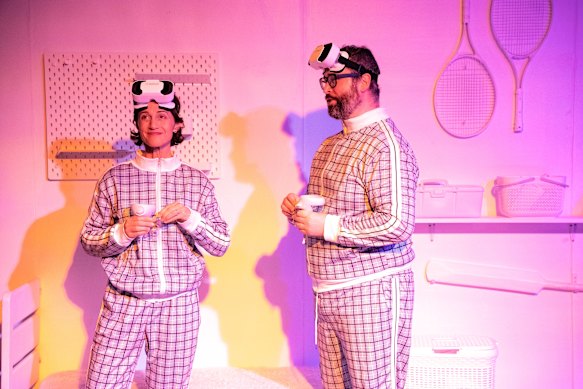
Nick Curnow as dad, Jane Wallace as mum in Instructions for Correct Assembly.Credit: Patrick Phillips
Which is often and, thanks to actor Ben Chapple, also very funny. Jän is just like a real boy, their real lost boy, until dinner table conversations turn to his new underage Chatswood prostitute girlfriend (zap) / undying love for the demure teen girl seated opposite him (zap) / desire to have sex with both her horrified parents.
From British playwright Thomas Eccleshare, Instructions for Correct Assembly is an absurd dark comedy from 2018, arriving with Clock & Spiel Productions for its Australian debut at Flight Path Theatre. If you remember the Be Right Back episode from the second season of Black Mirror, which also involves a “resurrected man” in a cardboard box, you’ll find yourself in the same neighbourhood of ideas.
This story is less melancholy, however, and far more unhinged. Presenting a bleak vision in falsely bright tones, director Hailey McQueen ushers forth shattered laughter at the insane consumer landscape of our dystopian technocratic future, and the false promises of god-like control it can give desperate people.
The many scenes are short and clipped, with background muzak playing in their blink. Jacob Parr’s set is a literal whitewash of the domestic interior – all shelves, tennis racquets, clothes and picture frames on the walls coated with the same vanishing brush.
Two timelines run (and blur): one leading up to Nick’s final spiral, and the other showing the parallel meltdown of Jän. There’s one fantasy wish-fulfilment scene that is devastating.
With a lesser cast and handling, Instructions might have seemed janky or uneasily offbeat. Thankfully, pitch-black humour often prevails. Jane Wallace and Nick Curnow process their characters’ grief and terrible guilt with a jaunty denial that covers nihilistic despair.
Their friends, who are always irksomely boasting about their children’s glittering futures, are David Allsopp and Jacki Mison, with Kyra Belford-Thomas as their ATAR-topping daughter.
Chapple is the stand-out though, especially as Jän – mining that uncanny valley for comedic gold. His unnatural motions and overly cheery voice; his complete lack of self-awareness; his indecent sincerity; his unnaturally bright eyes. In Nick, he finds a wretched realism.
Neither of his characters’ behaviour is predictable or programmable: there’s too much data overwhelm from the world at large. What healing or harmful role can technology play in the grieving process? How will companies see the void of loss as a gap in the market?
Instructions for Correct Assembly is an imaginative, playfully pessimistic yet compassionate work: a warning of technology’s tranquillising comforts, its faulty solutions and its own dehumanising addictions.